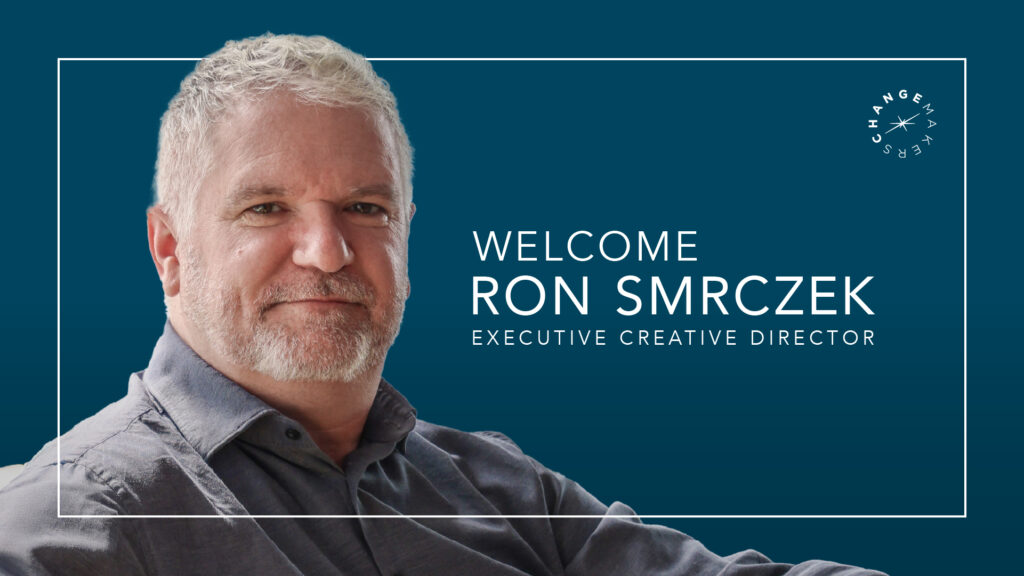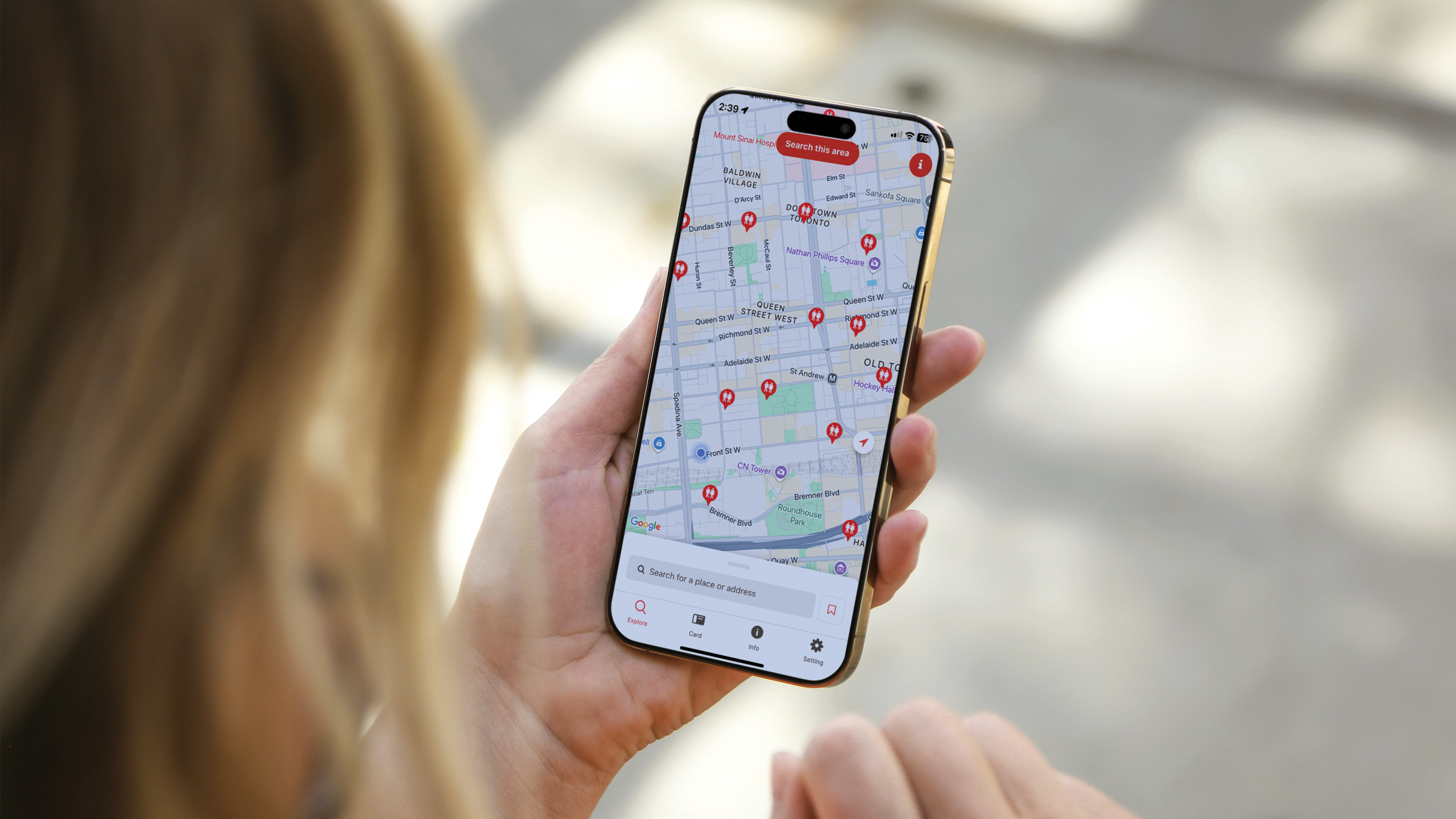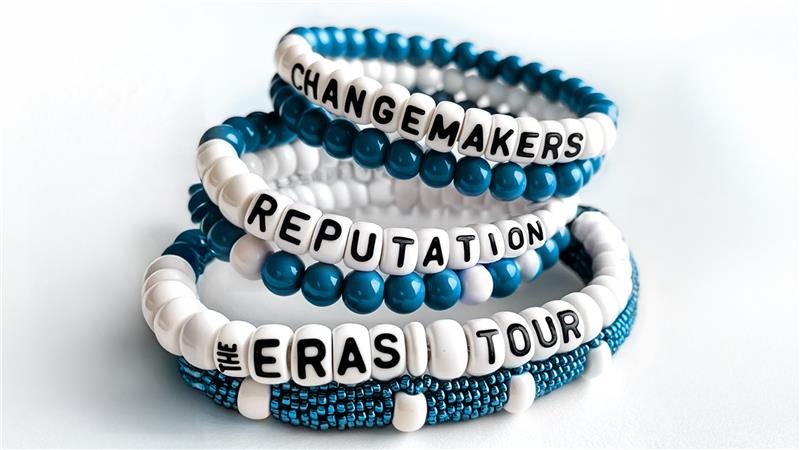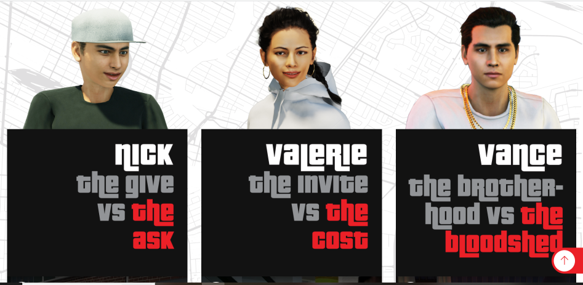What complex challenges can we help you navigate?
Email us:
health@thechangemakers.com

Marketing, Reputation Management, and Social Impact Consulting firm ChangeMakers has appointed creative leader Ron Smrczek as the company’s new Executive Creative Director.
A prominent figure in the agency creative community, Smrczek is known for his transformative work on leading brands in diverse business categories from Viagra (pharma) to Interac (finance), Canadian Tire (retail), and TELUS (telecom).
Over his 27-year career, he has worked at agencies including TAXI—across Toronto, Europe, and the U.S.—as well as Zulu Alpha Kilo, McCann, The&Partnership, and BBDO.
“Ron’s breadth of integrated experience on big brands and the creative leadership he has demonstrated internationally across so many business challenges will help us elevate our creative output throughout all our business lines,” says Alyssa Huggins, ChangeMakers President, Marketing. “We are also excited by his collaborative style and advertising-agnostic thinking that Ron will bring to our clients.”
For Smrczek, ChangeMakers’ in-house portfolio of discipline expertise provides the kind of resource base that is required in today’s marketplace.
“We are well into a new era where it takes much more than advertising or PR to tell the story of brands,” says Smrczek. “Companies need to tap into broader and more integrated areas of expertise, such as reputation management and social impact, to solve modern business problems.”
Adds Smrczek: “The challenge today is not so much about getting projects done, but more about meeting the changing needs of consumers and clients. You need to have the flexibility to meet problems as they arise—to have the expertise readily at hand that can guide clients through change as it happens.
“It also helps that ChangeMakers is independent. I’ve always felt independence brings the ability to put clients and people first”
About ChangeMakers
ChangeMakers is a 400+ person independent marketing, reputation management, and social impact firm with offices throughout North America. ChangeMakers combines deep business specialization with human-centered strategies, working alongside our clients to strengthen their brands and succeed in a disruptive world.
View the story at StrategyOnline:
“ChangeMakers appoints Ron Smrczek as its executive creative director”
https://strategyonline.ca/2025/04/02/changemakers-smrczek-ecd/
View the story at O’Dwyer’s:
“On the Move: Real Chemistry Taps Griffiths for 21 Grams Post”
View the story at CampaignCanada:
“ChangeMakers appoints Ron Smrczek as executive creative director”
View the story at AdNews:
“Smrczek joins ChangeMakers”

The Locked Out campaign faced several challenges to raise awareness for IBD and public washroom accessibility. The activation — a real portable toilet placed in a public space — often led to preconceived assumptions, mirroring the stigma those with IBD face when seeking washrooms. This reinforced the need for targeted engagement to shift perceptions.
Stigma remains a barrier, as understanding of IBD, its symptoms and patient experiences are often overlooked. Positioning the stunt within Crohn’s and Colitis Awareness Month and sharing educational information was essential to breaking down misconceptions. The campaign relied on knowledgeable event staff to effectively communicate the message, which was supported by QR codes, signage, and live app demonstrations to ensure accessibility and education.
Engaging passers-by required adaptable strategies to capture attention and encourage participation. Crohn’s and Colitis Canada’s network of advocates played a key role in staffing the event, providing credible voices to reinforce the campaign’s message. Maximizing visibility required a strategic mix of organic and paid social content, ensuring reach beyond the physical activation. Targeted media outreach focused on Toronto to optimize resources and drive coverage, reinforcing the campaign’s urgency and impact.
To effectively engage key stakeholders and promote the GoHere® app during Crohn’s and Colitis Awareness Month, we analyzed and applied existing research on the needs and challenges of those who live with IBD. It was important to understand disease prevalence and patient experiences to ensure our program resonated with audiences. We examined insights into public washroom access barriers, stigma, and the need for real-time solutions, ensuring our messaging addressed the most pressing concerns. We also leveraged Vividata research to deepen our understanding of audience behaviors and media consumption patterns. These insights guided our strategic approach, enabling us to craft compelling content, target key demographics, and maximize engagement across multiple channels.
IBD diagnosis rates in Canada are increasing – and so are the needs for support. There is no cure for IBD. Approximately 322,000 Canadians live with IBD, with new diagnoses every 48 minutes. Patients experience lifestyle impacts, including chronic abdominal pain, frequent bathroom visits, and fatigue.1 Addressing IBD requires a thoughtful, sensitive, and real approach to the stigma that patients experience. Our strategy balanced empathy with practical solutions to drive engagement and app downloads.
Additional research findings: IBD often develops in young adults, typically between 16 and 35 years old, but can occur at any age. A second peak may occur in individuals over 60. Both men and women are equally affected.1 Patients experience significant lifestyle and psychosocial impacts such as mental health, diet and nutrition, and work and social life; Psychiatric disorders frequently occur among those with IBD: An estimated 21% have clinical anxiety; and an estimated 15% have clinical depression.2
News and social media consumption habits: Mobile (hours per week)3: Gen Z: 16.8; Millennial: 10.1; Gen X: 12.8; Social applications (hours per week)3: Gen Z: 15.8; Millennial: 15.1; Gen X: 8.2; TV (hours per week)3: Gen Z: 14.4; Millennial: 17.5; Gen X: 16.5; Online (hours per week)3: Gen Z: 28.7; Millennial: 25.6; Gen X: 24.7.
Those who care for individuals who live with IBD, usually family members, close friends or partners of those diagnosed. Research revealed that 56 per cent of caregivers feel exhausted from caregiving duties, and 44% report anxiety.4 Women are more likely to take on the caregiver role for children with IBD.5 IBD caregivers in Canada are essential to the well-being of individuals living with the condition. We needed to show support for the care they provide and make them aware of the GoHere® app to increase downloads and usage.
Policymakers: Those who shape public policy and address issues through legislation and decision-making. For non-profit organizations, this audience can influence resources, support advocacy efforts and shape the broader environment in which Crohn’s and Colitis Canada operates. Engagement with policymakers was essential to raise awareness and garner support for washroom accessibility initiatives in a sensitive way to make it easy for this audience to share our messages. We needed a demonstration of local political support to increase awareness and action.
News Media and Social Media: We targeted top-tier health reporters, online news outlets, and Crohn’s and Colitis Canada’s active social platforms (FB & IG) to reach key audiences. Insights showed that Gen Z, Millennials, and Gen X spend significant time on mobile and social media, making a shareable, timely event essential. Personal patient stories highlighted the GoHere® app’s impact, driving awareness and downloads. Securing a national health reporter with a personal connection to IBD further amplified engagement within the IBD community.
Environmental Scan: To understand the IBD landscape, we reviewed media coverage and patient testimonials. Results showed IBD awareness remains low, and the stigma surrounding the disease often prevents open conversations. Public washroom accessibility and reduced stigma emerged as a critical need for IBD patients.

To reduce stigma, we had to find a way to visualize the realities of washroom access needs for those who live with IBD. To achieve this, we produced a powerful visual centerpiece – an ‘out-of-order’ portable toilet – representing the challenges faced by individuals with Crohn’s or colitis in accessing public washrooms quickly. Through earned and social media, this activation sparked conversation and action on the GoHere® app during Crohn’s and Colitis Awareness Month.

The campaign featured a high-impact public activation and a multi-channel communication strategy:
Call-to-Action: Event materials, earned and social media materials, and conversations encouraged attendees to scan the QR code and download the GoHere® app.
Event Execution: On November 26, 2024, we installed an ‘out-of-order’ portable toilet near Toronto’s Union Station to highlight the urgent need for accessible washrooms. Crohn’s and Colitis Canada staff and volunteers engaged the public with creative materials and a QR code for easy GoHere® app downloads.
Media Engagement: To broaden education beyond the event, we needed national media coverage for our story. This involved securing a nationally syndicated feature story, booking interviews for patient advocates and Crohn’s and Colitis Canada spokespeople, and sharing event photos with media outlets to provide audiences with the powerful visual to include in their stories.
Social Media Strategy: Organic and paid social media posts leveraged hashtags and influencer partnerships, and visual content from the event captured attention and drove app downloads.
Policymaker engagement: To amplify event support and impact, we engaged local MPs and MPPs to demonstrate their support. Mary-Margaret McMahon, MPP for Beaches-East York and Toronto City Councillor, Paul Ainslie, Scarborough-Guildwood, attended the event, shared on their social channels and encouraged GoHere® app downloads. This demonstration of local political support allowed for increased awareness and actionable items for local communities to consider.
Call-to-Action: Event materials, earned and social media materials, and conversations encouraged attendees to scan the QR code and download the GoHere® app.




Novel molecules, innovative mechanisms of action, new indications, loss of exclusivity, drug shortages, reimbursement challenges, evolving models of care… and the list goes on.
At ChangeMakers Health, we help clients navigate today’s complexities and anticipate tomorrow’s challenges — all in service of improving care and creating better lives for patients.
We partner with pharmaceutical companies, healthcare organizations and patient advocacy groups. Together, we help patients access potentially life-saving and life-changing medications and treatments. We educate patients and the public about chronic conditions and treatment options. We work to strengthen our healthcare system — ensuring people receive accurate, empowering information to support informed care with our dedicated healthcare providers.
To find out more, or engage our team, email us at:
health@thechangemakers.com


Crohn’s and Colitis Canada
Senior Manager, Communications and Public Relations
Meaningful change is not possible without collaboration because trust is foundational to great work. Our goal is to become an extension of your team, building a strong and lasting relationship






Email us:
health@thechangemakers.com



ChangeMakers is proud to announce a major win in health advocacy, securing a strategic partnership with the Alberta Association of Optometrists (AAO) to champion the importance of eye health for all ages.
Through a province-wide campaign, ChangeMakers will help spotlight the critical role of regular eye exams in early detection and prevention, from infancy through to senior years. This collaboration will not only strengthen awareness of eye health but will also mark the beginning of an exciting new client relationship.
“Our partnership with ChangeMakers reflects the agency’s understanding of our mission and its ability to bring it to life through compelling storytelling and strategic communications,” said Brian Wik, CEO at Alberta Association of Optometrists. “We look forward to working together to amplify our advocacy efforts and improve access to essential eye care services.”
As a leader in purpose-driven communications, ChangeMakers will support AAO with a multi-faceted strategy, including strategy, creative and content development, earned media, influencer strategy, digital marketing, and media buying.
“Our work with AAO reinforces ChangeMakers’ commitment to advancing meaningful causes through impactful marketing and reputation management,” said Alyssa Huggins, President of Marketing, at ChangeMakers. “We’re honored to support the Alberta Association of Optometrists in raising awareness of its vital initiatives that protect vision and improve lives across Canada and beyond.”
About ChangeMakers
ChangeMakers is a 400+ person independent reputation management, social impact and marketing firm with offices throughout North America. ChangeMakers combines deep business specialization with human-centered strategies, working alongside our clients to strengthen their reputation and succeed in a disruptive world.
About the Alberta Association of Optometrists
The Alberta Association of Optometrists is Alberta’s leading optometric professional organization, representing more than 900 Doctors of Optometry in over 120 communities across the province. AAO members are highly trained regulated health professionals providing primary eye health and vision care to Albertans. For more information, please visit optometrists.ab.ca.
View the story at StrategyOnline:
“ChangeMakers teams up with Alberta optometrists”
https://strategyonline.ca/2025/03/19/agency-news-hover-group/

When Taylor Swift announced her highly anticipated Eras Tour, she didn’t just ignite excitement among fans—she sparked a multi-year cultural moment that asked brands: are you …Ready for It? From themed campaigns to clever social media nods, companies across industries have tapped into the Swiftie phenomenon, hoping to ride the wave of her global Reputation. But in a world where bandwagon marketing often backfires, how can brands leverage cultural phenomena while staying true to their brand voice?
Taylor Swift’s presence in a city brings more than just All Too Well-attended shows—it drives local economies and creates endless PR opportunities. Ricola seized the moment with a playful campaign addressing the concert-induced “Swifty voice” from singing too loud. Meanwhile, the Toronto Humane Society cleverly named adoptable pets after Tay Tay’s hits to help animals in need break through the noise and find their adoptive Love Story. These initiatives aren’t just creative—they’re timely and authentic, tapping into the shared excitement of the moment to generate buzz.
Brands and organizations leaned on data to creatively join the conversation around the Eras Tour. Airbnb recognized the surge in tourism tied to Taylor Swift’s concerts and curated themed stays and local guides for a concert experience that Hits Different. This enhanced the fan experience while showcasing the power of leveraging travel trends. Similarly, Statistics Canada hit a Gold Rush by playfully connecting their data releases to Taylor Swift’s tour dates, proving that even government agencies can find engaging ways to intersect serious insights with cultural phenomenon, proving that a little strategy can lead to a State of Grace. While engagement on in-the-moment posts can seem like the Best Days of Your Life, most brands won’t see a long-term impact on their brand reputation from embracing Taylor’s Electric Touch. For brands exploring the opportunity, our proprietary ChangeMakers Reputation Score© can navigate these effects in real time, predicting risk and creating avenues for future growth, letting you approach these types of campaigns with Eyes Open.
Not every brand knows how to stay Fearless in the face of a cultural tidal wave. Jumping on a trend without careful consideration can leave brands in a place that feels Haunted, with consumers who won’t Tolerate It. Brands must always examine the downside before becoming too Enchanted with the potential upside. Reputation now accounts for roughly 70% of corporate value. Nothing is more important than protecting it. Inauthentic expression can be a recipe for disaster, especially if the messaging doesn’t align with your brand’s values. The best campaigns, like those mentioned, succeed because they reflect a deeper understanding of the audience and stay true to the brand’s purpose. Authenticity is key—fans can spot a forced attempt from a mile away, and the backlash can be swift (pun intended).
Taylor Swift’s Eras Tour offers a roadmap for how brands can harness cultural moments without losing their identity. The most impactful campaigns are creative and relevant. Look for ways to find your Blank Space in a crowded room while maintaining your brand’s authenticity. For PR and marketing professionals, the takeaway is clear: You Need to Calm Down and don’t just follow the trend—make it work for your brand in a way that adds value. Cultural moments like this don’t just create opportunities; they set the bar higher for meaningful consumer engagement.

In 2019, Winnipeg Police Service’s Gangs and Guns unit estimated Winnipeg had 25-30 gangs and up to 4,000 gang members and associates. In 2022, it was estimated that there were 40 street gangs, many of them Indigenous-led. Youth at risk of recruitment have often experienced childhood trauma or live in poverty — the ripple effect of oppression across generations. High dropout rates and few economic opportunities for youth also contribute to gang recruitment success. Manitoba Association of Chiefs of Police (MACP) secured funding from Manitoba Justice to help youth avoid or leave gang involvement and partnered with Argyle to develop a powerful campaign to promote off-ramps to vulnerable youth.
This initiative featured three short, impactful videos, illustrating the vast difference between the myth of what gang life offers and the reality of what it delivers. The concept used a popular video game look and feel to reach viewers aged 13-16 in a way they could relate to as well as share. A phone number at the end of each video encouraged viewers to send a text message to The Link: Youth and Family Supports, a trusted community agency offering a potential lifeline for those wanting help to leave or resist gang life.
We reached youth with a digital campaign on social platforms including Facebook, Instagram, Snapchat and TikTok. Additionally, targeted YouTube ads ran on specific gang awareness channels in Manitoba. The initial digital campaign ran for six weeks from July 26 to September 12, 2023, with a second phase from November 9 to Dec 15, 2023.
To effectively reach Manitoba’s youth, Argyle worked closely with the Winnipeg Police Service’s anti-gang unit and reformed gang members to ensure our message, tone, visuals, and call to action resonated with young audiences.
Our research included the following:
As a result of our research, we learned:
Our goal
Through a public education and awareness campaign, we would offer vulnerable youth off-ramps to avoid or leave gang involvement and teach them about the harmful realities of gang life versus the myths used during recruitment.
Our strategy
To achieve this goal, we leveraged the lived experience of the reformed gang members we met to reach youth with authentic, real-life gang recruitment scenarios. As a first-year objective, we wanted to get young people’s attention, raise awareness and build trust. This is the starting point for a long-term approach to impacting gang recruitment. Helping influence youth to not move towards gang life was our goal, and one potential indicator would be the number of texts sent to The Link from youth looking for help. Our partnership with The Link was key as they have been serving youth in Winnipeg and northern Manitoba for close to 100 years. They are well known by youth, approachable and credible. Trust was the leading factor needed to encourage youth to click on the ad, visit the website, watch the videos and text for help.
| Objective | Metric |
|---|---|
| Awareness Get young people’s attention to the risks of gang life | 2 million advertising impressions 2 media coverage pieces about the launch |
| Trust Encourage youth to click on the ad, visit the website and watch the videos | 3,000 clicks to the link’s website |
| Action Help influence youth to avoid / move away from gang life | 30 youth using the text helpline |

Using the insights we learned from our research, we developed three videos to address common scenarios within gang life including illegal drugs, sexual exploitation and gun violence based on real-life stories we heard about from our reformed gang member advisors. To make the videos attractive and relatable to youth, the style was based on popular video games, and we developed Gang Life is No Life characters, storylines and a call to action. In each of the three 15-second videos we were able to establish an action from a gang recruiter (The Ask; The Invite; and The Brotherhood) and then the resulting detrimental outcomes (The Give; The Cost; and The Bloodshed).
The background settings created for these three videos depict scenes common to many towns and cities within Manitoba. From a social housing project, to a mall, to a downtown scene that is recognizable as Winnipeg with its overhead walkways, the familiarity helped create a sense of authenticity and credibility – an important point we learned in our research and knew we had to achieve.
To make the action easy for youth, the end board offers the call to action to “text 204-910-6010 to get out”, and names The Link as the community agency offering help. Based on insights from our research, we deliberately did not include the MACP brand in the videos to ensure the message would be credible to youth.
The Gang Prevention Campaign was launched on July 26, 2023, with a news conference hosted at The Link. Emceed by steering committee chair Inspector Grant Stephen from the RCMP’s Federal Serious and Organized Crime Unit, the event featured a representative from Organized Crime with the Winnipeg Police Service (Inspector Elton Hall), a founder and action therapist from Spirit Horse Initiative whose team provides support to youth on the streets of downtown Winnipeg (Matt Davidson), and the CEO of The Link (Kerri Irvin-Ross). Media interest at the event was impressive with coverage from CTV, Global, CBC, Winnipeg Free Press, Winnipeg Sun and ChrisD.ca. There were also over a dozen organic social media posts thanks to partners including RCMP, Winnipeg Police Service, MACP, The Link and Spirit Horse Initiative.
We brought the videos to life with a digital campaign across social platforms popular with youth including Facebook, Instagram, Snapchat, and TikTok. Additionally, targeted YouTube ads ran on specific Manitoba gang awareness channels that we learned were frequented by youth interested in learning about gang activity across the province. The digital campaign launched for six weeks from July 26 – Sept 12 with a second six-week phase from Nov 9 – Dec 15.

The campaign exceeded the client’s expectations, both on reach and engagement. On the ground, police enforcement tactics to reach youth attracted to gang recruitment had never before seen such success:
“Our gang prevention coordinator works with agencies in the community to provide an offramp for young people to exit gangs or the lifestyle. She has been very successful in referring youth to agencies over the previous three years. On average, she has provided assistance to between 20 and 30 youth annually. The Gang Life Is No Life campaign has provided an avenue for youth to connect directly to The Link and other social agencies at any time of the day, discreetly. This media campaign has resulted in over 150 referrals in a short period of time,”
Inspector Elton Hall, steering committee member from the Winnipeg Police Service.
Inspector Hall presented this campaign and its results to law enforcement audiences over the past few months. There is an appetite for replicating this approach in other jurisdictions both within Canada and into the US. MACP has secured funding from Manitoba Justice to continue the campaign in 2024. Creative ideation and planning are underway to build on our momentum.
11.68M
impressions
45,666
clicks to the Gang Life Is No Life webpage on The Link’s site
150
text conversations from 109 unique phone numbers
6
media outlets (print, TV, online)
SnapChat and TikTok were the most successful tactics of the campaign, demonstrating both strong click-through rates and low cost-per-click. This indicates a strong alignment between messaging and the target audience on these platforms.



Novel molecules, innovative mechanisms of action, new indications, loss of exclusivity, drug shortages, reimbursement challenges, evolving models of care… and the list goes on.
At ChangeMakers Health, we help clients navigate today’s complexities and anticipate tomorrow’s challenges — all in service of improving care and creating better lives for patients.
We partner with pharmaceutical companies, healthcare organizations and patient advocacy groups. Together, we help patients access potentially life-saving and life-changing medications and treatments. We educate patients and the public about chronic conditions and treatment options. We work to strengthen our healthcare system — ensuring people receive accurate, empowering information to support informed care with our dedicated healthcare providers.
To find out more, or engage our team, email us at:
health@thechangemakers.com


Taking up more than 17% of healthcare professionals’ time each week, health misinformation is pulling focus from patient care. At ChangeMakers Health’s recent panel, we unveiled key findings from our debut report.
The conversation was powerful and the data is clear.
Crohn’s and Colitis Canada
Senior Manager, Communications and Public Relations
Meaningful change is not possible without collaboration because trust is foundational to great work. Our goal is to become an extension of your team, building a strong and lasting relationship






Email us:
health@thechangemakers.com



Pharma ads aren’t trying to be clever – just compliant
My son’s hockey team was down 1-0, and the third period was drawing to a close. I sat in the stands watching anxiously, trying to focus on the game. However, I couldn’t help eavesdropping on the parents next to me talking about pharmaceutical advertising. As someone who’s worked in pharma advertising for years, my ears perked up.
“What I don’t get is why they won’t tell us what the drug is for,” said the parent. “It’s all just, ‘See your doctor.’ I mean, What’s with the mystery?!”
“Well, I’m sure there’s a good reason,” said the other parent, oblivious to the score. “Maybe they are trying to be clever.”
I’m grateful there was a youth hockey game to distract me because every fibre of my being longed to leap out of my seat and shout at the top of my lungs: “We’re not being cute! We’re being compliant!”
To those who aren’t well-versed in the complexity of pharmaceutical advertising in Canada, pharma ads can seem purposefully vague and mysterious. No mention of what the drug actually does and what condition it treats. Just a cryptic “talk to your doctor” at the end. What many people don’t understand is that in Canada, direct-to-consumer, or DTC, marketing is subject to Section C.01.044 of the Food and Drugs Act, which states that if advertising a prescription drug to the general public, only the brand name, the price and quantity of the medication can be referenced.
It is quite literally against the law to mention the therapeutic use of a prescription drug in Canadian consumer advertising. Additionally, all pharmaceutical content undergoes rigorous internal reviews – by Medical, Regulatory and Legal Departments – and external evaluation by Ad Standards Canada.
This makes marketing pharma very different from marketing other products; imagine trying to create an ad for paper towel where you can’t mention it cleans up spills! But, DTC is vital because there is a need for pharmaceutical communication and brand building. Canadians need encouragement to speak with healthcare professionals about disease care. Canadian patients want to be educated and empowered with the tools to engage their healthcare providers in dialogue about their health. Pharma ads are an important part of that education.
For example, look at a common – and growing – disease like diabetes. According to Diabetes Canada, there are millions of Canadians living with prediabetes and type 2 diabetes (T2D) who don’t know it. T2D is one of the fastest growing diseases, with more than 60,000 new cases diagnosed annually. And the effects of T2D can be debilitating. Encouraging Canadians to speak with a healthcare professional, which is what advertising and communications do, is vital to our health.
DTC that connects
Because the stakes are high, research-based pharma would love to be more direct with Canadians. But strict regulations require a different approach. So how can pharma engage their audience in a compelling way while navigating the complexity of the regulations? Some best-practices our award-winning team at ChangeMakers has used:
Sometimes being in a restricted environment prompts innovative thinking. Some of the best campaigns I’ve worked on were pharma – not in spite of regulations, but because of them. Necessity is the mother of invention, and being hemmed in can bring out the best in creative and strategy.

We find ourselves in the teenage years of the dominant social media platforms – Facebook is 20 years old; Instagram is 14; and 18-year-old Twitter has angrily changed its name to X. As with any teenager, volatility is the norm. Recent years brought us the mountainous rise of TikTok, the faltering of Twitter, the birth of Threads, the rise and fall of the metaverse, Bill C-18, Apple’s app tracking transparency, and generative AI for all. There’s been a tremendous amount of change.
Constant change and disruption are woven into the fabric of the digital landscape. So how do communicators and marketers navigate these rapid transformations of technology, norms, and tastes? There are really only two choices – radical change every quarter or create a long-term, stable social strategy. The former is going to consistently get you into trouble, the latter will set you up for success for years to come.
Just because platforms are volatile doesn’t mean brands have to be. Amidst the chaos, the smart move is to create integrated strategies that bring together social, creative, media, and web teams to curate moments and create ownable content focused on measurable goals.
If users don’t win, everyone loses
We are in the midst of a fierce battle for attention. Consumer ability to jump toward shiny new platforms is forever shifting how social media properties operate. As communicators, we should be rooting for more success, not failure. A healthy, competitive social media ecosystem is better for all of us as it incentivizes communicators to create compelling messaging.
Meta’s platforms, along with TikTok’s, increasingly suffer from a proliferation of out-of-touch and socially disconnected ads. A surge in poorly crafted – and often auto-generated messaging results in user disengagement; they post less frequently, see less of what they want, and before you know it, you’re in a platform death spiral. This cycle creates a worse environment for users, contributing to declining diversity, doom-scrolling and deteriorating mental health – which is a lousy environment for organizations to communicate in with users.
No one should add to this deterioration. Marketers and communicators must be thoughtful about what we bring to the party. Audiences want to be seen and acknowledged, and they crave relevant content. Brands who lead with authenticity and demonstrate they understand the diversity of their customers’ values will continue to flourish.
Paid and organic: BFFs
Organic reach is dead. But that doesn’t mean organic efforts should be abandoned. It just means that paid campaigns and organic publishing shouldn’t operate in silos, and certainly not with distinct teams behind them. Organic and paid should be part of the same strategy conversation – with creative and media at the table. Paid and organic can complement each other strongly. Organic audiences are engaged supporters, driving content views, comments and organic website sessions. Organic content nurtures and informs those who know your brand or your perspective. These audiences are your most loyal, and insights from their actions and interests will inform your paid audience targeting, and your next round of creative content planning. On the flip side, within your best-performing social media content – that’s tested across millions of targeted impressions and dozens of AI-powered creative treatments – lies the spark for your next most engaging organic content.
Bigger! Better! Fewer!
Face it, very few are waiting for your organization’s next social media post. You should be communicating when you have something relevant to say. It’s more effective to focus your integrated social media efforts within your brand’s own schedule. Find your most meaningful and most impactful moments. Pick your times to speak, and break through with meaning, authenticity, and the weight of a focused ad spend to drive higher exposure for the moments that matter (to you and your audiences). Less is more!
Bigger moments are more likely to align with strategic outcomes. And social media outcomes should be a means to an end, aligning with actual business objectives. Your organization is not powered by impressions and likes. Calibrate your conversions and turn on an ecosystem that is fine-tuned to nurture first-party customer data – data from which you can grow more meaningful relationships. Engaged audiences are more likely to connect through to your websites, your ecommerce shop, your CRM initiatives and your physical assets.
Embrace platform formats
The smartphone is the TV of today. And vertical video is its 22-minute sitcom. XDR screens and 5G networks have made social media feeds the perfect place for vertical video entertainment. Steve Jobs dreamed of an entertainment and communications device for the park bench, the bus and the bathroom. And now we have it, full-screen and lightning fast. Today, content carrying your message needs to resonate with your mobile viewer within just 2 seconds. This is why your creative and social media teams should integrate from the start, so that possibilities are never missed. Your content planning and production stream can be designed to incorporate native platform truths, from the start. The format is vertical, short, and quickly engaging – with branding and key message right up front.
Because social media is so volatile, we as marketers need to be extra-focused on stability. When users, platforms and policies ebb and flow, integration and cohesion are our secret weapons. Increase the proximity between social, creative, media and web teams. Lead with authenticity. Embrace and test new platform formats. These are the efforts that enhance immediate success during these platform teen years and prepare us for weathering the expected volatility ahead.

Everybody has heard the phrase “The Medium is the Message,” Marshall McLuhan’s famous contribution to the study of communication. It may seem like a complex theory from a philosophical genius, but it’s actually quite intuitive. McLuhan is saying the medium through which information is transmitted shapes and influences our perception and understanding of the message itself. If you watch a commercial on TV, the very fact that it’s a TV ad is going to change how the audience understands it. McLuhan was thinking about this in the 60s just as TV was rising to mass media prominence, reaching tens of millions of people simultaneously. If VW had a commercial at half-time at the Super Bowl, we all saw the same thing at the same time, in the same context. And context is what McLuhan was focused on.
But people no longer watch TV in the traditional sense – they consume content on multiple devices: casting, streaming and binging content free from a set time and location. The proliferation of digital media has transformed the traditional mass communication model into a more personalized and one-to-one communication paradigm. Context is now continuously changing as digital messaging can follow us from browsing, to streaming, to scrolling – constantly shifting mediums. This begs the question: do we still need to consider McLuhan’s thesis? Can’t we, as marketers, advertisers and communicators now just focus on the message?
The answer is a resounding no. McLuhan’s insight is more significant than ever, but with one huge difference. Marketers during TV’s reign had to take TV’s context into account to craft relevant messaging; now we need to actively create relevant context alongside relevant content.
We can’t ignore the fact that McLuhan’s world looked vastly different in the 1960s, when TV was the silver bullet to achieve reach. The duopoly of Google and Meta collectively could begin to approach something resembling that reach a decade ago, but a multitude of changes (technology, competition, further fragmentation in the digital space) have made it increasingly difficult to achieve true mass reach with any one channel. Audiences have never been more fragmented. So, we’re faced with a difficult challenge: with reach being a fundamental predictor of success, it has become increasingly more difficult to achieve, and is further complicated by challenges that make it difficult to evaluate true reach. Measurement of reach is hindered by the closed ecosystems of the big online giants, limitations around cross-device tracking, ad-blocking and privacy regulations.
TV brought us tremendous reach – but it was a blunt instrument. Scale, yes. Ability to be relevant to individuals? Not so much. We can approximate some of the scale with digital, but we now have tools to deliver messaging with incredible control over the who and the where. As we plan communications to deliver maximum results, precision vs. scale becomes the quandary. A broader reach strategy will achieve a broader audience, but at the cost of precision. This broad approach has its place; it is effective for awareness, driving household penetration for brands, campaigns and organizations, reaching people who may not fit neatly into specific segments. Yet mass is no longer the silver bullet it used to be as today’s consumers expect creative content to be relevant to their needs, interests and preferences. They want content that addresses their specific pain points, desires or challenges. We see that McLuhan is still as right as ever, the Medium is the Message – but now the medium (and thus the message) is personalized.
The who and the where are the priorities for effective digital communication. Creating the who and the where must go hand in hand with creating the messaging for it to be relevant. We know relevant messaging drives engagement and builds stronger connections. And in a medium that promises continual personalization, users will become desensitized to generic or repetitive messaging. Relevancy helps combat fatigue while delivering results: boosting CTRs, driving higher conversions and continuing to engage and retain audiences.
As today’s media landscape continues to evolve, communicators and advertisers need to strike the right balance of reach and relevance to deliver successful campaigns, resulting in messaging that is not only seen by the right people but is seen in environments where they make sense and resonate with their audience. With relevance comes the seemingly impossible task of achieving scale while delivering personalized content.
McLuhan is as relevant as ever. The medium is speaking as much as the message, and everyone needs to listen to what it’s saying: personalization. From strategy to creative, media-buying to execution, ChangeMakers understands this core truth, and we’re equipped to bring the right data sets together to ensure an audience-first approach is embraced across our disciplines and departments. When the quality of attention you achieve is arguably more important than scale, having a deep understanding of audiences and context is not only a fundamental pillar in communication, but arguably the starting point for everything.
We find ourselves in the teenage years of the dominant social media platforms – Facebook is 20 years old; Instagram is 14; and 18-year-old Twitter has angrily changed its name to X. As with any teenager, volatility is the norm. Recent years brought us the mountainous rise of TikTok, the faltering of Twitter, the birth of Threads, the rise and fall of the metaverse, Bill C-18, Apple’s app tracking transparency, and generative AI for all. There’s been a tremendous amount of change.
Constant change and disruption is woven into the fabric of the digital landscape. So how do communicators and marketers navigate these rapid transformations of technology, norms, and tastes? There are really only two choices – radical change every quarter or create a long-term, stable social strategy. The former is going to consistently get you into trouble, the latter will set you up for success for years to come.
Just because platforms are volatile, doesn’t mean brands have to be. Amidst the chaos, the smart move is to create integrated strategies that bring together social, creative, media, and web teams to curate moments, and create ownable content focused on measurable goals.
We are in the midst of a fierce battle for attention. Consumer ability to jump toward shiny new platforms is forever shifting how social media properties operate. As communicators, we should be rooting for more success, not failure. A healthy, competitive social media ecosystem is better for all of us as it incentivises communicators to create compelling messaging.
Meta’s platforms, along with TikTok’s, increasingly suffer from a proliferation of out-of-touch and socially disconnected ads. A surge in poorly crafted, and often auto-generated messaging results in user disengagement; they post less frequently, see less of what they want, and before you know it, you’re in a platform death spiral. This cycle creates a worse environment for users, contributing to declining diversity, doom-scrolling, and deteriorating mental health – which is a lousy environment for organizations to communicate with users.
No one should add to this deterioration. Marketers and communicators must be thoughtful about what we bring to the party. Audiences want to be seen and acknowledged, and they crave relevant content. Brands who lead with authenticity and demonstrate they understand the diversity of their customers’ values will continue to flourish.
Organic reach is dead. But that doesn’t mean organic efforts should be abandoned. It just means that paid campaigns and organic publishing shouldn’t operate in silos, and certainly not with distinct teams behind them. Organic and paid should be part of the same strategy conversation – with creative and media at the table. Paid and organic can complement each other strongly. Organic audiences are engaged supporters, driving content views, comments, and organic website sessions. Organic content nurtures and informs those who know your brand or your perspective. These audiences are your most loyal, and insights from their actions and interests will inform your paid audience targeting, and your next round of creative content planning. On the flip side, within your best performing social media content – that’s tested across millions of targeted impressions, and dozens of AI powered creative treatments – lies the spark for your next most engaging organic content.
Face it, very few are waiting for your organization’s next social media post. You should be communicating when you have something relevant to say. It’s more effective to focus your integrated social media efforts within your brand’s own schedule. Find your most meaningful and most impactful moments. Pick your times to speak, and break through with meaning, authenticity, and the weight of a focused ad spend to drive higher exposure for the moments that matter (to you and your audiences). Less is more!
Bigger moments are more likely to align with strategic outcomes. And social media outcomes should be a means-to-an-end, aligning with actual business objectives. Your organization is not powered by impressions and likes. Calibrate your conversions and turn on an ecosystem that is fine-tuned to nurture first-party customer data – data from which you can grow more meaningful relationships. Engaged audiences are more likely to connect through to your websites, your ecommerce shop, your CRM initiatives, and your physical assets.
The smartphone is the TV of today. And vertical video is its 22-minute sitcom. XDR screens and 5G networks have made social media feeds the perfect place for vertical video entertainment. Steve Jobs dreamed of an entertainment and communications device for the park bench, the bus, and the bathroom. And now we have it, full-screen and lightning fast. Today, content carrying your message needs to resonate with your mobile viewer within just 2 seconds. This is why your creative and social media teams should integrate from the start, so that possibilities are never missed. Your content planning and production stream can be designed to incorporate native platform truths, from the start. The format is vertical, short, and quickly engaging – with branding and key message right up front.
Because social media is so volatile, we as marketers need to be extra focused on stability. When users, platforms, and policies ebb and flow, integration and cohesion are our secret weapons. Increase the proximity between social, creative, media, and web teams. Lead with authenticity. Embrace and test new platform formats. These are the efforts that enhance immediate success during these platform teen years and prepare us for weathering the expected volatility ahead.
ChangeMakers offices and team members are located across North America within the traditional, Treaty, and unceded territories of First Nations, Inuit, and Métis Peoples.
Our team is currently engaged in the development of a Truth and Reconciliation Action Plan for our company. The Truth and Reconciliation Commission of Canada called upon the corporate sector in Canada to “adopt the United Nations Declaration on the Rights of Indigenous Peoples as a reconciliation framework and to apply its principles, norms, and standards to corporate policy and core operational activities involving Indigenous peoples and their lands and resources” (Call to Action 92).
Our Action Plan is an important measure we are taking as a company and we look forward to updating with more information about this plan and the actions that reflect our commitments as a team.